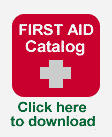What is Sudden Cardiac Arrest?
Sudden cardiac arrest (SCA) simply means that the heart unexpectedly & abruptly quits beating. This is usually caused by an abnormal heart rhythm called ventricular fibrillation (VF).
Is SCA the same as a heart attack?
No. A heart attack is a condition in which the blood supply to the heart muscle is suddenly blocked, resulting in the death of the heart muscle. Heart attack victims usually (but not always) experience chest pain and usually remain conscious. Heart attacks are serious and sometimes will lead to SCA. However, SCA may occur independently from a heart attack and without warning signs. SCA results in death if not treated immediately.
Who is at risk for SCA?
While the average age of SCA victims is about 65, SCA is unpredictable and can strike anyone, anywhere, anytime.
What is VF?
VF is an abnormal heart rhythm often seen in SCA. This rhythm is caused by an abnormal and very fast electrical activity in the heart. VF is chaotic and unorganized; the heart just quivers and cannot effectively pump blood. VF will be short lived and deteriorate to asystole (a flat line) if not treated promptly.
How is VF treated?
The only effective treatment for VF is an electrical shock called defibrillation. Defibrillation is an electrical current applied to the chest. The electrical current passes through the heart with the goal of stopping the VF and giving an opportunity for the heart’s normal electrical system to take control. This current helps the heart reorganize the electrical activity so it can pump blood again. An automated external defibrillator (AED) can defibrillate the heart.
What is an AED?
An AED is a device that analyzes and looks for shockable heart rhythms, advises the rescuer of the need for defibrillation and delivers a shock if needed.
Will I hurt the victim by using an AED?
When used on people who are unresponsive and not breathing, the AED is extremely safe. The AED makes shock delivery decisions based upon the victim’s heart rhythm, and will only defibrillate a shockable rhythm.
What if I forget the steps for using an AED?
The steps for shocking an SCA victim are simple and straightforward. The AED Plus® provides visual and audio prompts required for the entire resuscitation process. The most difficult part is recognizing the need for defibrillation.
Should I perform CPR first or apply electrode pads from the AED?
Do CPR only until the AED arrives. Apply the electrode pads to the victim's bare chest and follow the voice prompts and messages of the AED. It will tell you when to resume CPR.
If defibrillation is so important, why should I do CPR?
CPR provides some circulation of oxygen rich blood to the victim’s heart and brain. This circulation delays both brain death and the death of heart muscle. CPR also makes the heart more likely to respond to defibrillation.
Can I be sued using an AED?
To date there has never been a case where someone was held liable for using an AED, but as you know, anyone can be sued. Likewise, most states have passed “Good Samaritan” legislation protecting the lay rescuer from lawsuits.
Can I accidentally shock another rescuer or myself?
AEDs are extremely safe when used properly. The electric shock is programmed to go from one electrode pad to another through the victim’s chest. Basic precautions, such a verbally warning others to stand clear and visually checking the area before and during the shock, will virtually ensure the safety of rescuers.
What if the victim has a medication patch on or EKG electrodes on the chest where I want to place the electrode pads?
Never place AED electrode pads directly on top of medication patches, such as nitroglycerin, or EKG patches. Patches should always be removed and the skin wiped dry before placing electrode pads on the skin.
Do I need to remove the electrode pads before performing CPR?
No. The electrode pads remain on throughout the resuscitation and until the victim is transferred to advanced care providers such as the paramedics. If the electrode pads are in their correct locations on the victim’s chest, they will not interfere with proper hand placement or compressions.
Should I use the AED if the victim has a pacemaker or is pregnant?
Yes, never withhold AED use in a person with SCA.
Can I defibrillate on a wet surface?
Yes, as long as the usual safety rules are observed. Be sure the victim’s chest is wiped dry. Keep the electrode pads away from a damp or conductive surface.
Can I defibrillate on or near a metal surface?
Yes, as long as the usual safety rules are observed. Keep the electrode pads away from contact with the conductive surface. Be sure not to allow anyone to touch the victim when a shock is delivered.
How much of the victim’s clothing should be removed to carry out defibrillation?
The chest should be exposed to allow placement of the disposable electrode pads. A woman’s bra should be removed. Clothes may need to be cut off.
Why is it so important to be sure that the electrode pads are firmly adhered to a clean, dry chest?
Successful defibrillation requires electricity to flow from one electrode pad to the other through the chest. If the electrode pads are not firmly adhered and there is sweat or another conductive material between the electrode pads, the electricity will be more likely to flow across the chest rather than through it. This will result in ineffective defibrillation and an increased chance of sparks and fire.
Is it okay to place the electrode pads directly on a hairy chest?
Electrode pads must come in direct contact with the skin. If the chest hair is so excessive as to prevent good adhesion of the electrode pad, the hair must be removed quickly.
What if I have a child victim?
You should use pediatric electrode pads, which carry a lower charge to the child in SCA.
After I have successfully defibrillated the victim, do I keep the electrode pads on?
Yes, even after a victim has been successfully defibrillated, he/she is at risk of developing VF again. The AED will continually monitor the victim for the return of VF. If VF is suspected, the AED will automatically begin to analyze victim after two minutes of CPR is complete. The AED should be left on until emergency personnel assume responsibility for the victim.
What if the victim regains a pulse but is not breathing or is breathing slowly?
You should give rescue breaths at a rate of 1 every 5 seconds or 12 per minute.
I used an AED on a SCA victim and the AED always prompted “No Shock Advised”. Even with CPR the victim did not survive. Why didn’t the AED shock this victim?
Although VF is the most common rhythm in cardiac arrest, it is not the only one. The AED will only shock VF or VT (ventricular tachycardia), which is a very weak but fast heart rhythm. There are other heart rhythms associated with SCA that are not treated with defibrillation shocks. A “no shock advised” message doesn’t mean the victim’s heart rhythm is back to normal.
I shocked a woman in SCA within minutes after she collapsed. I hear later that she did not survive. Did I do something wrong?
Unfortunately, because of other underlying medical or heart problems, not all victims of SCA who are in VF will survive even if defibrillation is done promptly & correctly.
What if I don’t perform all the steps of CPR and defibrillation perfectly?
SCA is a high stress situation. Even experienced health care providers do not do everything perfectly. In SCA, performing CPR and using an AED can only help the victim.
What if I’m not certain whether or not I need to use an AED?
Remember this rule: only use an AED on someone you would do CPR on – unresponsive and not breathing. |


![]()














